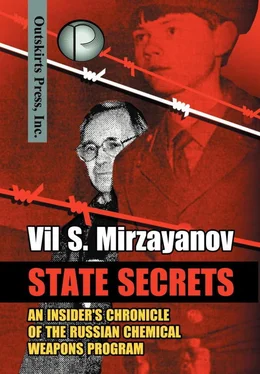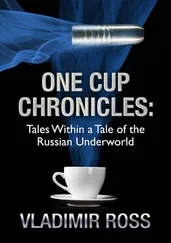You couldn’t expect anything else from Drell, who was notable for his devil-may-care attitude towards safety. According to one of his senior researchers, Sergei Davydov, he forced his employees to work with mustard gas, without any protection and even to sniff its vapors, so they could remember the smell. After this unfortunate accident, Kolyada was obliged to retire, and she died a year later of cancer.
Some of the safety violations at GOSNIIOKhT were due to the ignorance or carelessness of its employees. For example, safety procedures required that anyone transporting samples of dangerous chemicals from one part of the facility to another must place the test tubes in portable steel containers with activated charcoal strewn on the bottom, to absorb the agent in case of an accident. This was supposed to offer the carrier some protection. Safety regulations also required small-scale laboratory work with hazardous chemicals to be accomplished in cabinets with exhaust hoods that sucked the air inside the cabinets away from the workers, allowing them to perform many procedures without full gas masks. [49] According to these regulations, the linear velocity of the air sucked by the ventilation into the laboratory exhaust hood had to be at least 1.0 meter per second to guarantee the safety of personnel. Every exhaust hood has a chart attached to it where the date and the last measured air velocity are logged, and if these measurements are lower than the standard norms, any operations with chemical agents must be terminated.
As I prepared for an experiment connected with transforming Substance 33 into a stable aerosol, a beautiful, young research assistant appeared in my room, but without a container. My jaw dropped when she took three test tubes out of her pocket with her bare hands and quietly placed them in the safety cabinet. To this day, I still reproach myself for not reprimanding her for her carelessness because she died of lung cancer a couple of years later. [50] Some people in the U.S. are telling me that Substance 33 or VX-gas could not cause cancer, but they are forgetting that Substance 33 never was a pure product. It was a chemical agent of about 80% purity, contaminated with a lot of other compounds. Among them there were also some products of composition with three and more sulfur atoms.
Other dangers at GOSNIIOKhT resulted from a misplaced trust in out-dated safety procedures. Every five years, the Decontamination Department was responsible for revising all the safety manuals, which contained descriptions of decontamination methods, checks for completeness of safety precautions, and safety and first aid rules. Instead, the department merely reissued the manuals without making any significant changes, despite real improvements in safety technologies and practices. Misguided trust in the old ways is the reason that the process to sanitize items contaminated by soman was not changed for decades. I personally analyzed the decontamination solutions that GOSNIIOKhT used, and I always found that the decontamination solutions did not destroy significant quantities of agents such as sarin and soman. [51] These solutions were so ineffective that they did not even destroy the chemical agents to the level of permissible concentration, and that is a major safety shortcoming.
According to GOSNIIOKhT’s safety manuals, glassware and gloves could be used again, unless they were broken or torn after cleaning with these decontamination solutions. Since the administration was too stingy to supply us with fresh gloves, GOSNIIOKhT laboratory workers were compelled to reuse ones that were still contaminated. Safe practice calls for protective gloves to be used only once.
The danger for GOSNIIOKhT’s workers was clear, and matters were made even worse by the fact that the waste water, from rinsing the allegedly decontaminated glassware and gloves, ran directly into the Moscow city sewer system, carrying with it the residues of undestroyed chemical agents. When gloves were torn, instructions required the scientist to cut to them up into narrow strips, which were placed in bags that were sent to Moscow’s garbage sites. Arguably, such lax safety practices put human health and the environment at risk, both inside and outside of GOSNIIOKhT’s territory.
The Soviet Army preached an entire philosophy of reusing previously-contaminated equipment, weapons, and clothing. This approach was deeply wrong, but General Anatoli Kuntsevich, the commander of the military chemical complex at Saratov, had developed his own methods of decontamination. When I applied this decontamination solution on steel test plates to model the use of Kuntsevich’s decontamination solution on military equipment, I was shocked to find that all of the samples contained a hundred times more than maximum permissible concentration of sarin. [52] I was not the only chemist to note the deficiencies of the decontamination solution that the Russian Army continues to employ. General Nikolai Antonov, the former commander of Military Unit 61469, has also written about this problem. See N. S. Antonov, Khimicheskoe oruzhie na rubezhe dvukh stoletii, Progress (Moscow: 1994): 64. These terribly insufficient decontamination methods caused me to publicly oppose the plans of Ministry of Chemical Industry, which was planning to use the factory at Novocheboksarsk to destroy chemical weapons. Unit 83 in this factory produced Substance 33, and the walls of this facility remain irreversibly contaminated with Substance 33. Nevertheless, V. P. Ivanov, the Minister of Chemical and Petrochemical Industry accused me of significantly increasing the costs of Russia’s chemical weapons destruction program if the Novocheboksarsk facility could not be used. See Annex 51 for the full text of secret letter no. 629 from V. P. Ivanov, Chairman of Committee for Chemical and Petrochemical Industry to S.D. Balashov, Head of the Investigation Department at the Ministry of Security of The Russian Federation, pertaining to case no. 62 (Moscow: 13 April 1993).
The safety practices in Military Unit 61469 were particularly egregious. Soldiers took unreasonable risks and there were open safety violations. I was horrified to see an officer bring a couple kilograms of soman to his work station and open a container to take samples without using any safety measures whatsoever. When I asked why he was so “brave” and taking such risks, he simply replied that he was “a chemical officer.”
Perhaps the most significant safety shortcut that GOSNIIOKhT’s hierarchy took was with the very air that its employees breathed. Employees at the main laboratory building at GOSNIIOKhT were constantly breathing an atmosphere partially composed of exhaust air. GOSNIIOKhT had powerful ventilators, but this ventilation system was largely redirecting exhaust air into the workrooms, and on days when the atmospheric pressure dropped, the exhaust air from the safety hoods would spread out close to ground level in the rooms. On such days, it was literally impossible to breath in the laboratories, and it was not uncommon to see people in gas masks rushing out of the main laboratory building. [53] In collaboration with Dr. Igor Revelsky, I conducted research that demonstrated the hazards of GOSNIIOKhT’s ventilation system. The reports that our two laboratories produced on this problem were ignored because an entirely new ventilation system would have to be designed to fix the problem. The cost of this monumental task was more than the system could bear.
The same was true on the eve of Soviet holidays, when according to the rules all rooms had to be free of all chemical agents (old and newly synthesized ones) and their precursors. For almost a week all scientists and assistants were busy destroying these hazardous substances in huge quantities under the hoods creating contamination in the ventilation exhausts.
Читать дальше












